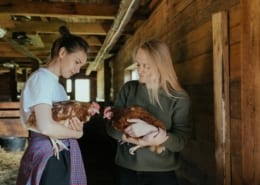Permaculture is about integrating animals, plants and humans into a balanced and sustainable ecosystem. However, one of the main challenges is ensuring the right plants are grown alongside the right animals! This course is ideal for those who have completed the Certificate of Permaculture Foundations course, farmers looking to diversify the use of their land or those passionate about sustainability and self-sufficiency.
The Certificate of Animal Permaculture is an online professional development program that will teach you about the relationship between permaculture systems and animals and how the benefits can be maximised through design and cultural management decisions.
In this Animal Permaculture course, you will gain insights into how a variety of animals can enhance a permaculture environment, including insects; poultry; bees; grazing animals like sheep, goats, pigs and rabbits; and larger livestock and wildlife.
You will also study how to plan and prepare garden ‘zones’, the role of aquaculture production systems in permaculture, and the range of aquatic species suitable for permaculture systems.
On completion of this course, you will have developed your ability to integrate animals and their resources – from insects and aquatic organisations to grazing animals and livestock – into a viable permaculture design.
Course Structure
Unit: Permaculture III - Animals
Unit 1 – Integrating animals into a permaculture system or garden
- Locating animals in a permaculture system
- Maintaining a balance in the system
- Sectors
- Intensive animals, small livestock and free-range animals
- Functions of animals in the system
- Fodder trees
- Birds in permaculture
Unit 2 – Roles in insects and other small animals
- Ecosystem components
- Ecological concepts
- The web of life
- Insects
- Lifecycles
- Insect classification
- Insect feeding habits
- Insect control
- Earthworm and red worms
- Snail farming
- Controlling pests
- Applied insect control
- Pollutants in the ecosystem
Unit 3 – Poultry
- Roles in permaculture
- Chickens, turkeys, ducks and geese
- Don’t buy sick birds
- Hatching chicks
- Poultry products and uses
- Poultry forage (useful plant species)
Unit 4 – Bee keeping
- Bee hives and lids
- To bar hives (TBH’s)
- Supers, bases and excluders
- Frames and foundations
- Spur wheel embedder
- Emlocks, bee smoker, hive tools
- Bee brush
- Locating a hive
- Buying an established hive
- Nucleus hives
- Swarms
Unit 5 – Grazing animals (pigs, sheep, goats and rabbits)
- Advantages and disadvantages of working off grass
- Paddock size
- Types of fencing
- Water supply
- Shelters
- Pig production systems
- Environmental controls
- Sheep
- Rearing and management systems
- Goats
- Rabbits
Unit 6 – Managing larger livestock and wildlife
- Managing larger grazing animals
- Beef cattle
- Dairy cattle
- Choosing your dairy breed
- Health and disease
- Managing milk
- Deer
- Alpacas
- Llamas
- Horses at grass in small areas
- Wild animals
- Wildlife management
Unit 7 – Aquaculture production systems
- Pond size
- Polyculture
- Manures and fertilising ponds
- Feeding fish
- Mariculture
- Littoral
- Advantages and disadvantages of aquaculture
- Production systems – EP and IP
- Species to grow
- Biological filtration systems
- Clearing turbid water in dams
- Protecting fish
- Water requirements
- Extensive production (EP) dams
- Intensive production fishery (IPF)
- Cages
- Harvesting fish
- Seine nets
- Gill nets
- Trap types and lines
Unit 8 : Aquaculture species to grow
- Bass, cod, perch, catfish, river blackfish and red claw
- Yabbies
- Spiny freshwater crayfish
- Trout farming
- Trout and water
- Determining flow in source water
- Temperature and trout
- Dissolved oxygen and trout
- Stocking rates for production pools
- Spawning and checking trout
- Fertilisation of ova
- Hatching the ova
- Barramundi (case study)
- Growing marron (case study)
Study Hours
Estimated duration 50 hours
Course Delivery and Start
Start anytime, self-paced and 100% online
Assessment
Assessment will be comprised of written exercises, including short-answer questions, reflective tasks, short reports and/or projects. There are no examinations or due dates for assessment. As a result, you can complete training in your own time and at your own pace with the assistance of unlimited tutor support.
Testimonials
Graduation
A Certificate of Attainment and Statement of Results will be issued upon successful completion of this course.
How to Enrol
Enrol Online: Click Enrol Now (Credit Card) or Enrol Now (Internet Banking/BPAY)
Enrol via Live Chat (Business Hours)
Enrol via Telephone 1300 76 2221 (Business Hours)
Enrol via Purchase Order/Tax Invoice
Enrolling Multiple Staff?
To enrol multiple staff, please complete the Employer Enrolment Form. We’ll be in touch within 60 minutes during business hours!
Payment Options
Visa, Mastercard, BPAY and Direct Deposit.
Course FAQs
Why Choose Australian Online Courses?
- Professional development that is widely recognised and respected;
- Improve your employment opportunities;
- Study online, anywhere via our elearning system;
- High-quality professional development programs written by industry experts;
- All course materials provided online – no textbooks to buy;
- Unlimited tutor support via email;
- We offer twelve (12) months’ access, with extensions available upon application (fees apply);
- Course may be tax deductible; see your tax advisor.
Are there any entry requirements or pre-requisites?
To study online with Australian Online Courses you will need a computer (desktop PC/laptop) running a current/updated operating system with reliable high-speed internet access. You will need to use the Google Chrome browser to access your course.
Are there any computer requirements?
To study online with Australian Online Courses you will need a computer (desktop PC/laptop) running a current/updated operating system with reliable high-speed internet access. You will need to use the Google Chrome browser to access your course.
When can I start this course?
You can start within 60 minutes during business hours when you enrol and pay in full with a credit card!
Credit card: Within 60 mins during business hours.
BPAY: Within 1-2 working days.
Internet Banking: Within 1-2 working days.
Cheque/Money Order: Upon receipt of mailed cheque.
How is this course delivered?
This course is delivered online via our easy-to-navigate Learning Management System (LMS), where you will discover interactive online learning/written content, resources and assessment.
Do I need to attend classes or undertake any work placements?
No. All courses are delivered online via our LMS and there are no work placement requirements in this course.
What support can I expect from Australian Online Courses?
Unlimited tutor support is available throughout your studies via email only during business hours Monday to Friday. Our Administrative team are available Monday to Friday via email, live chat and telephone.
I am an international student. Can I enrol into this course?
Yes! We accept enrolments from individuals both within Australia and internationally; location is no barrier to entry into our programs.
Career Pathways
Future growth
Strong
Unemployment
Low
- Permaculturist
- Farmers or hobby farmers
- Students with a passion for self sufficiency or sustainability.










